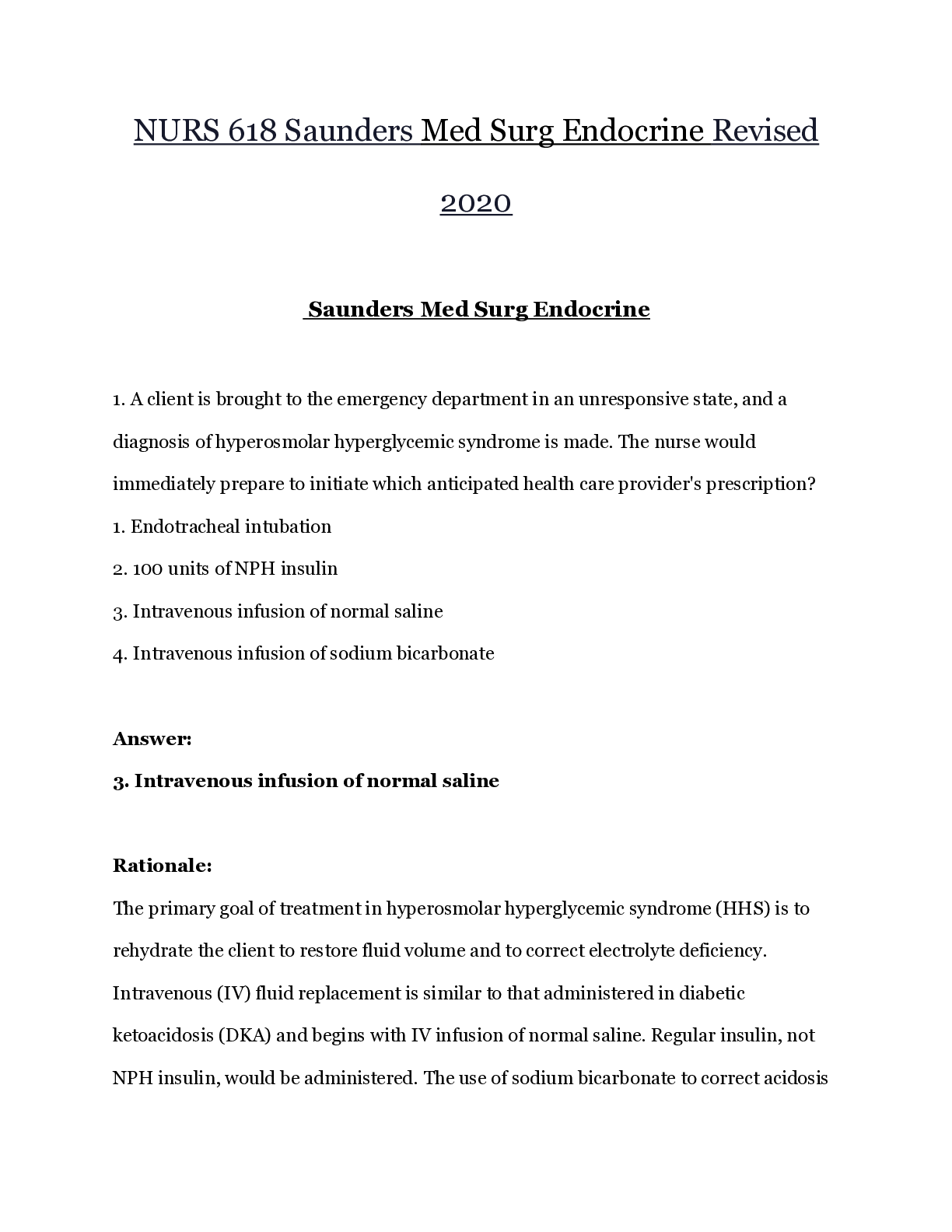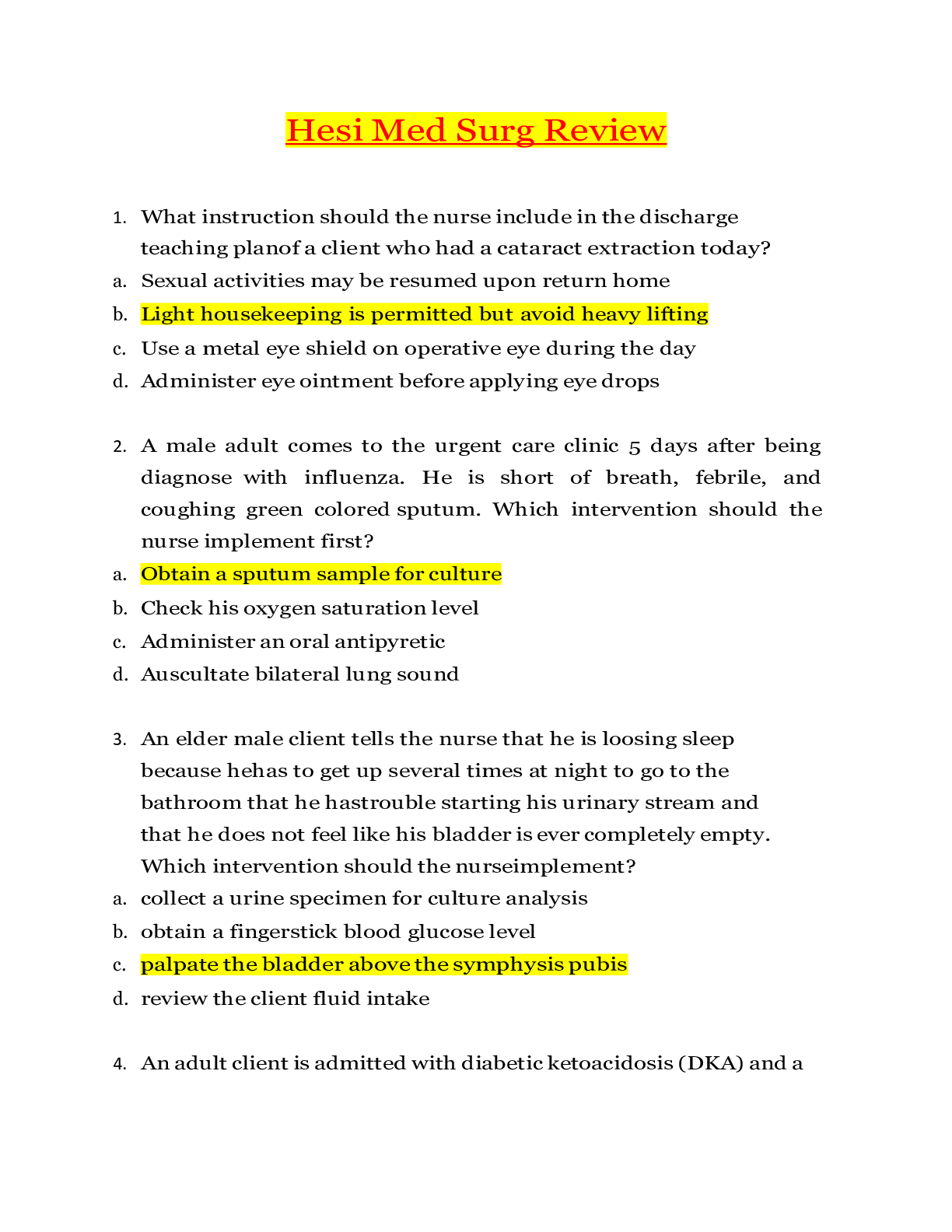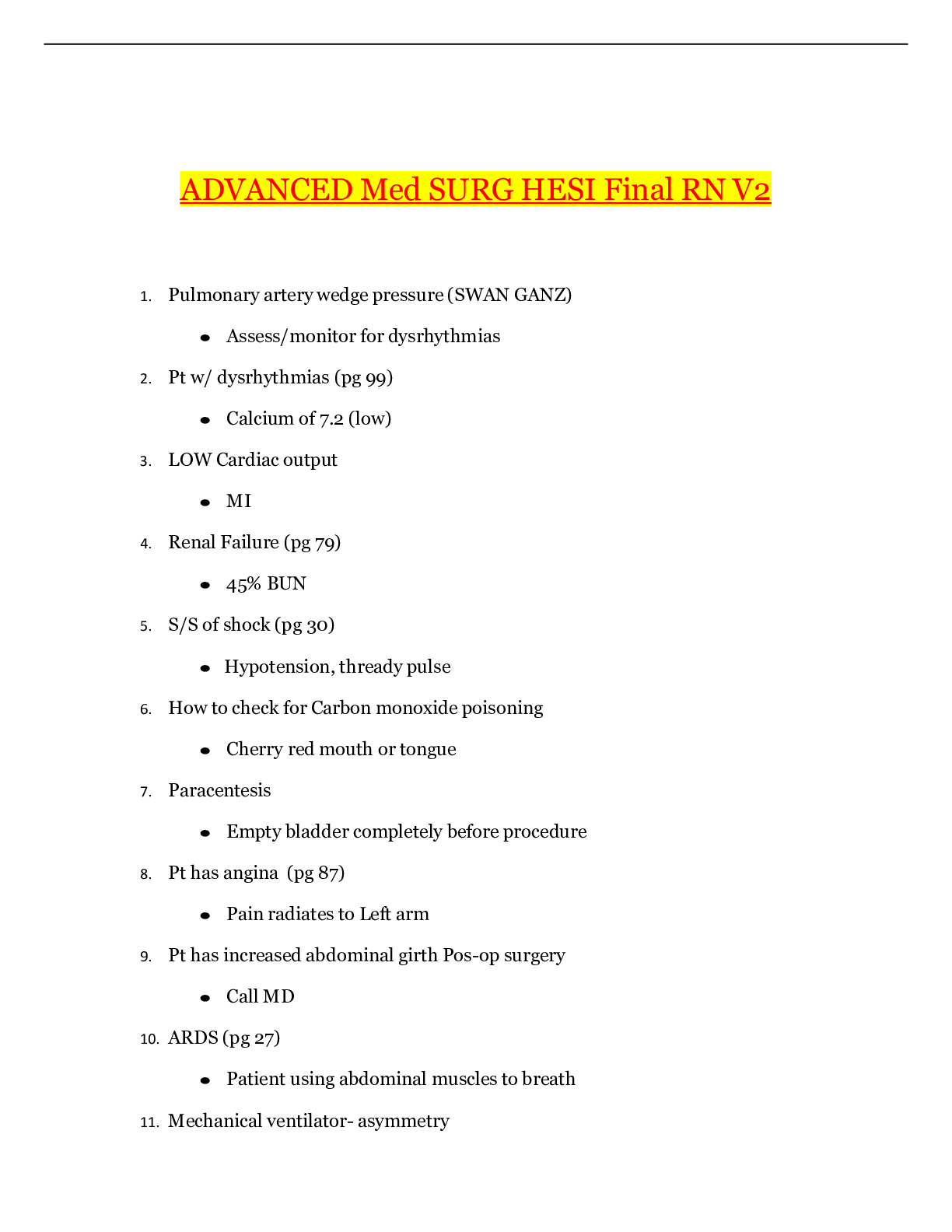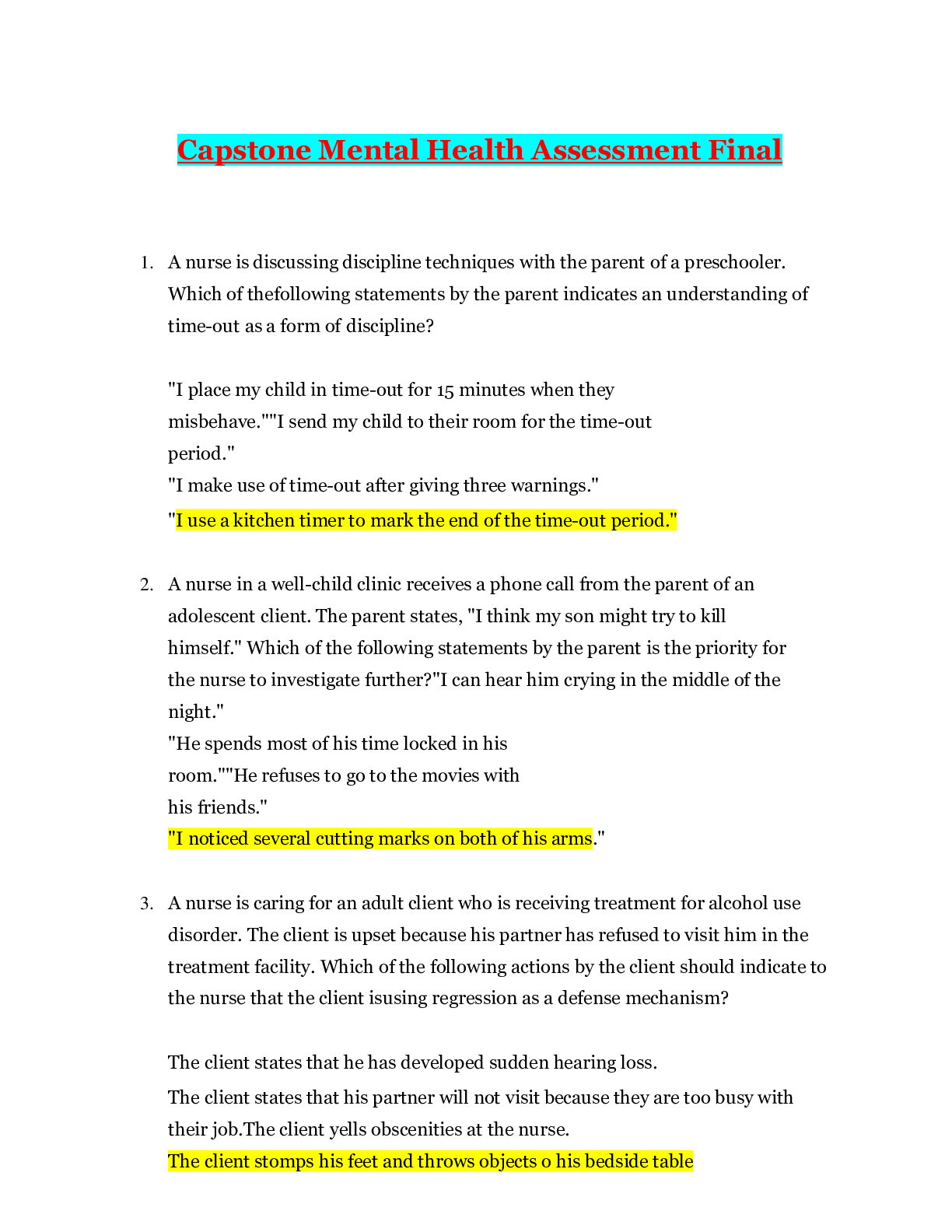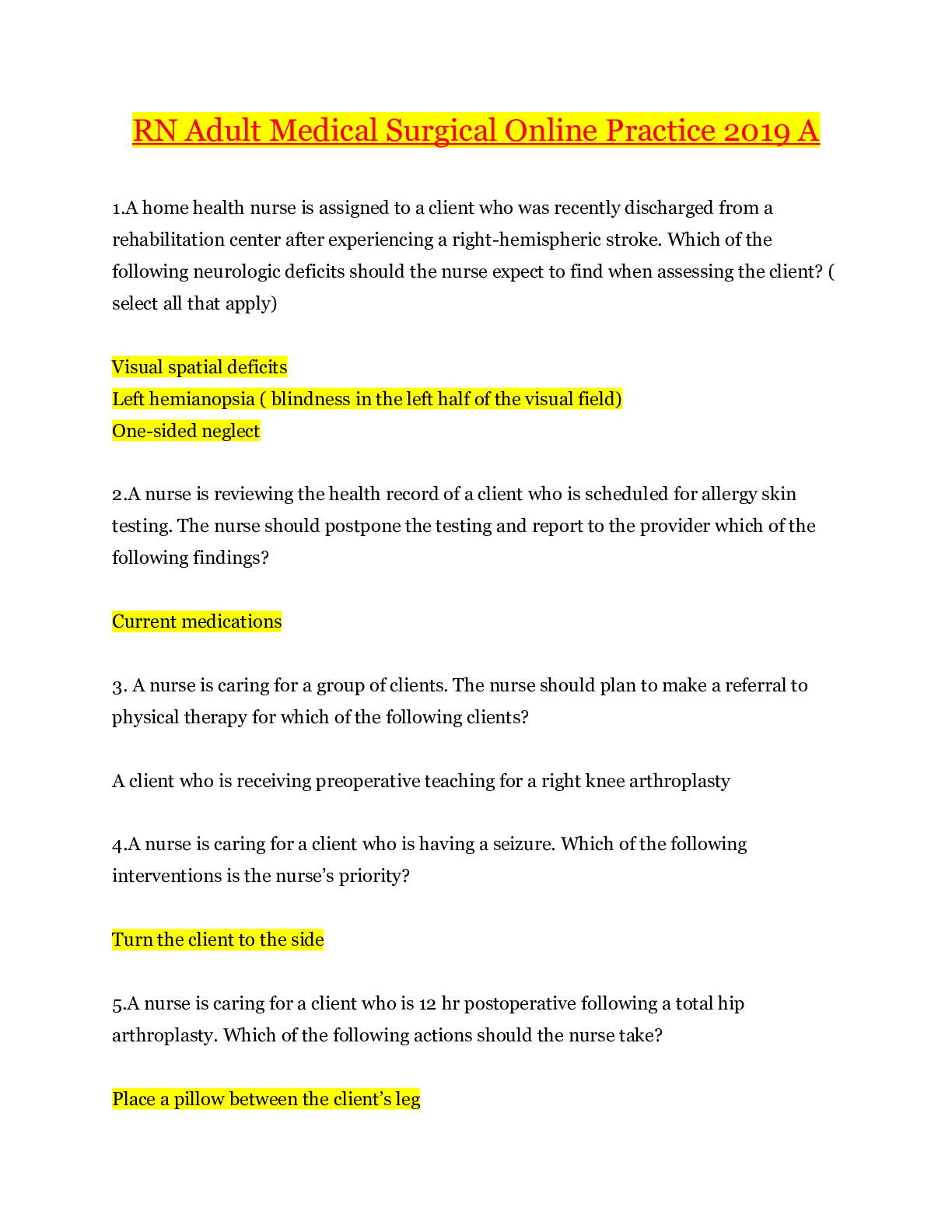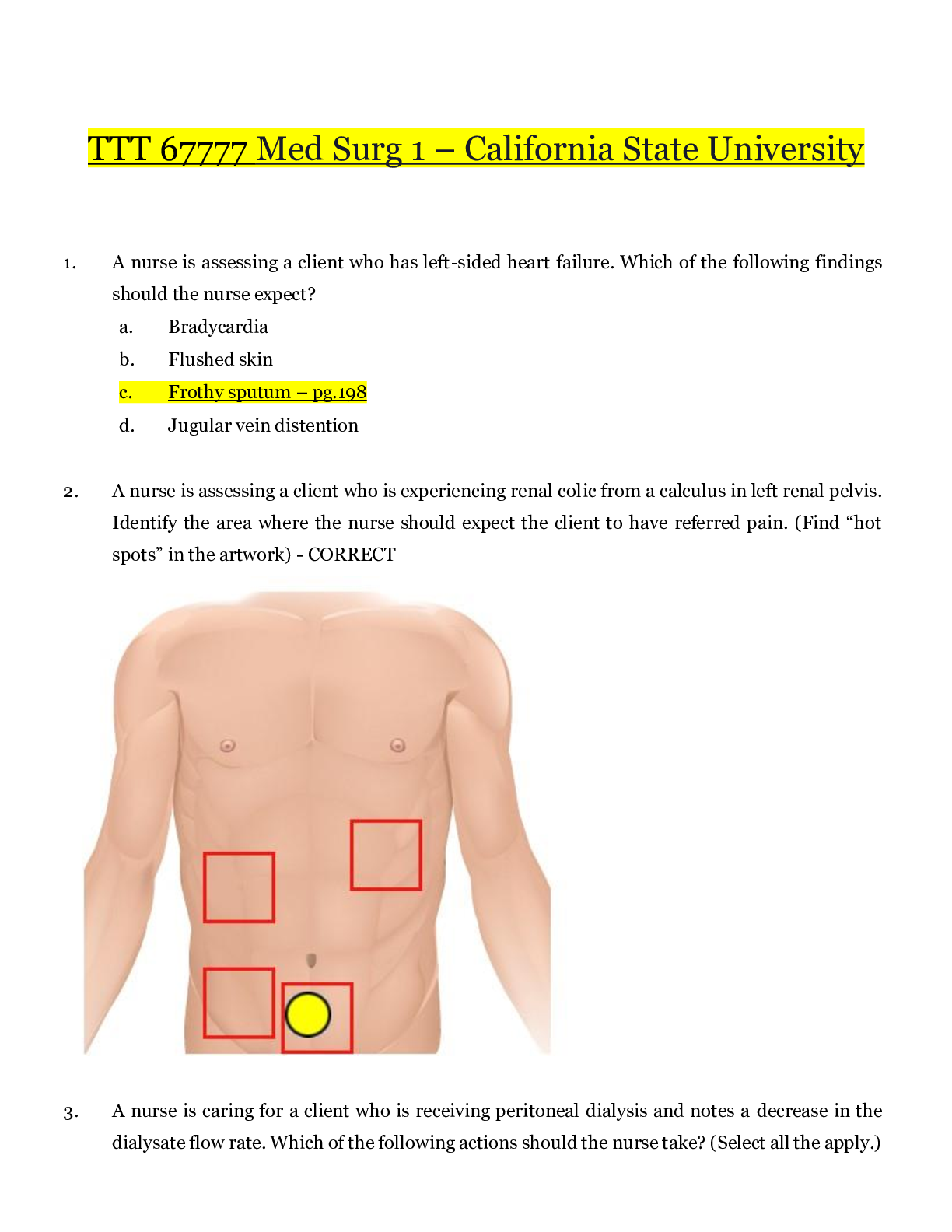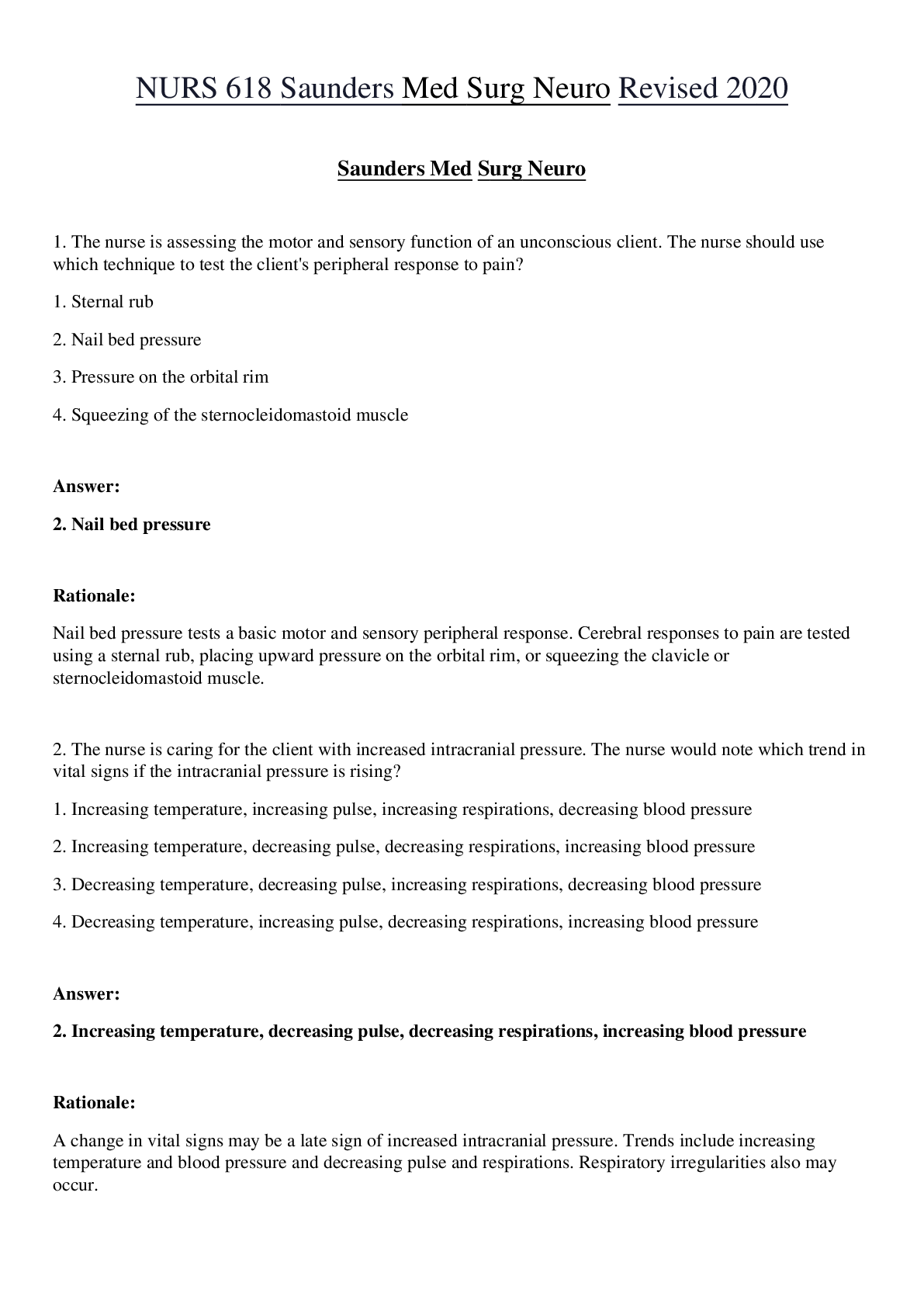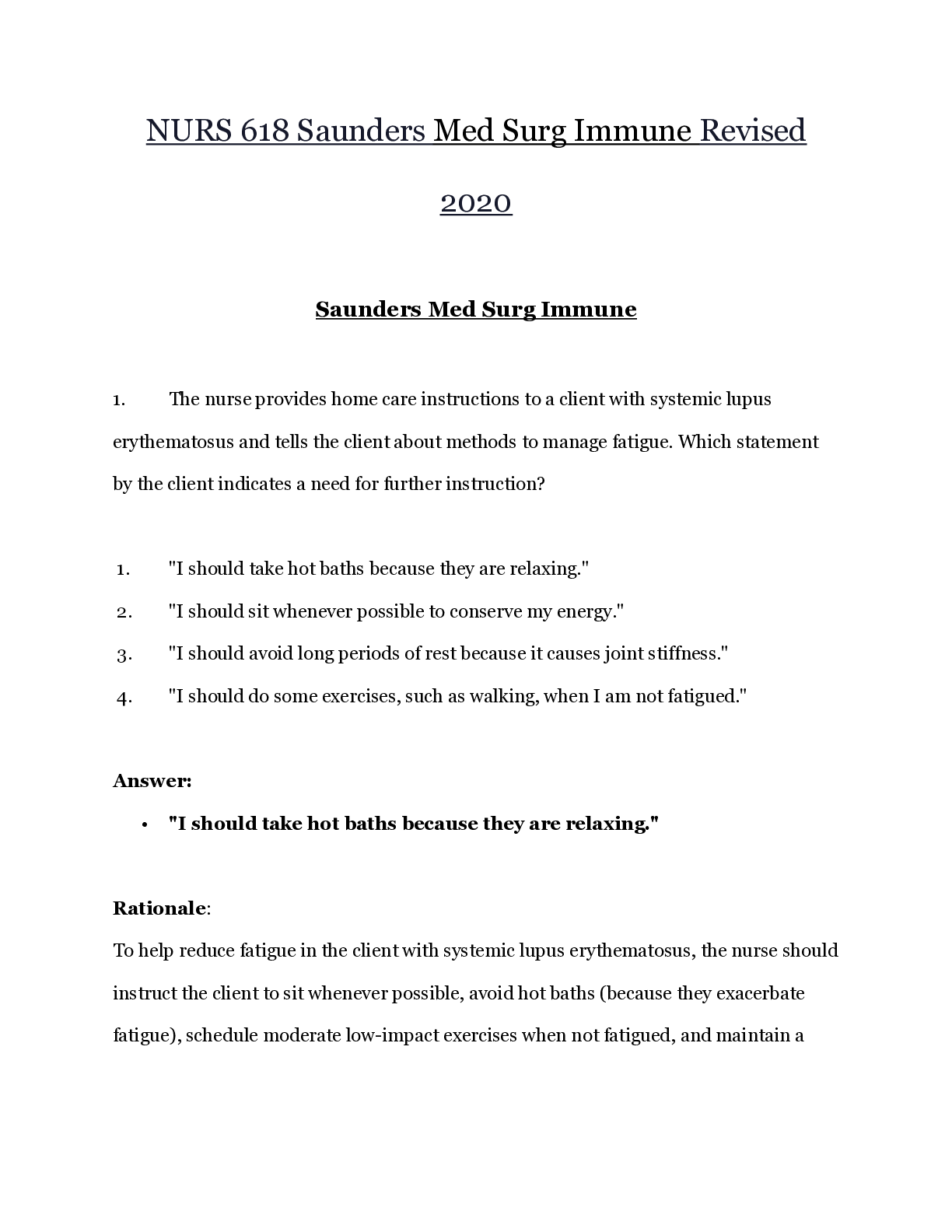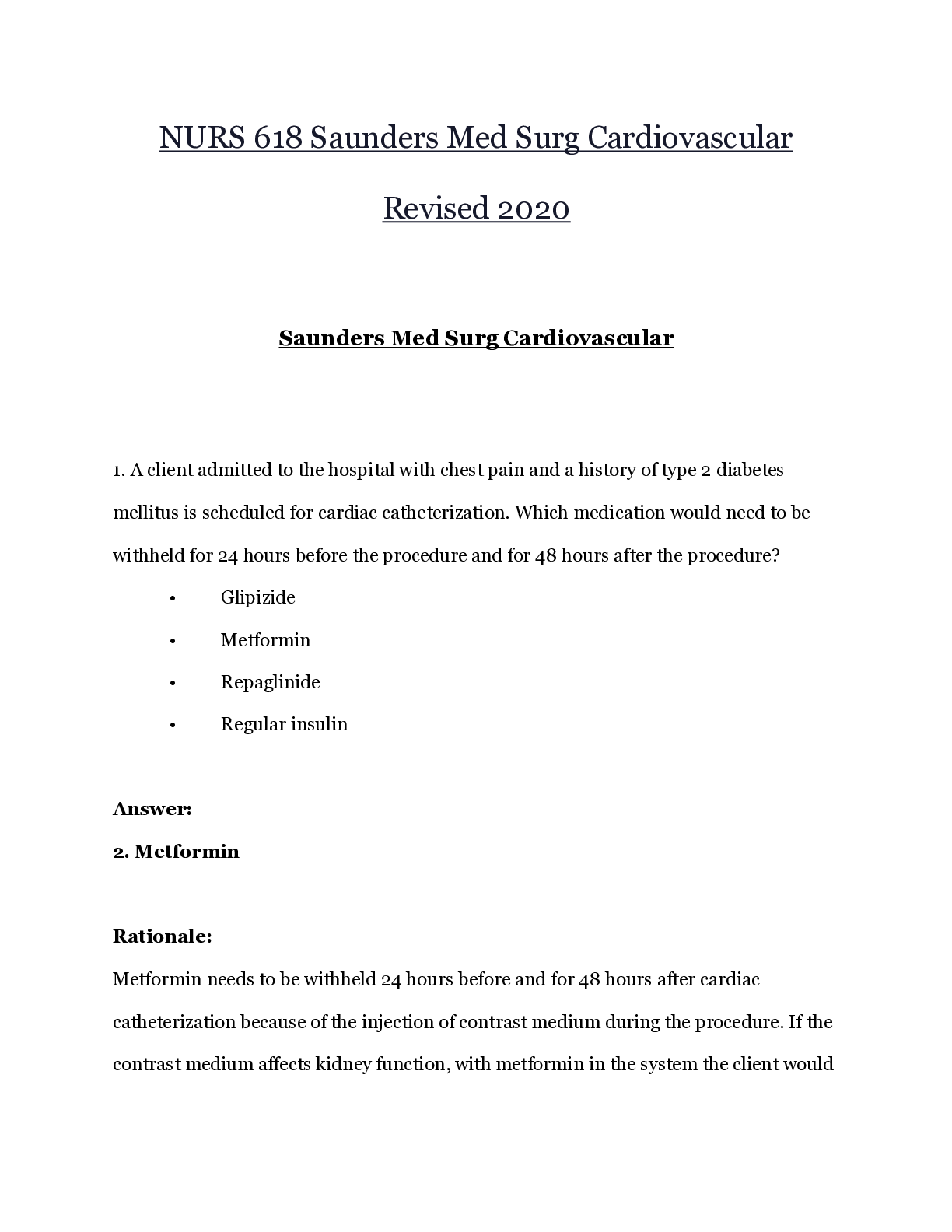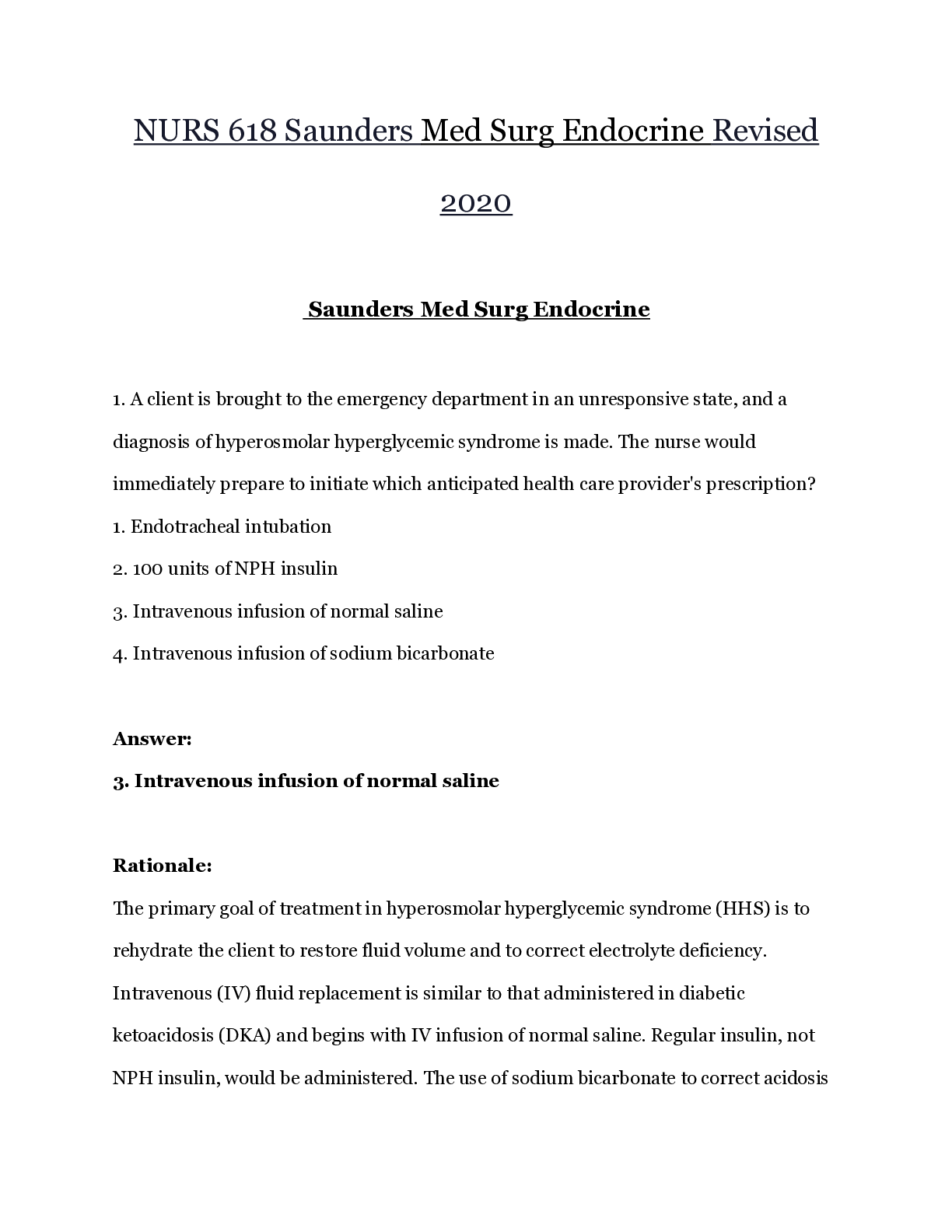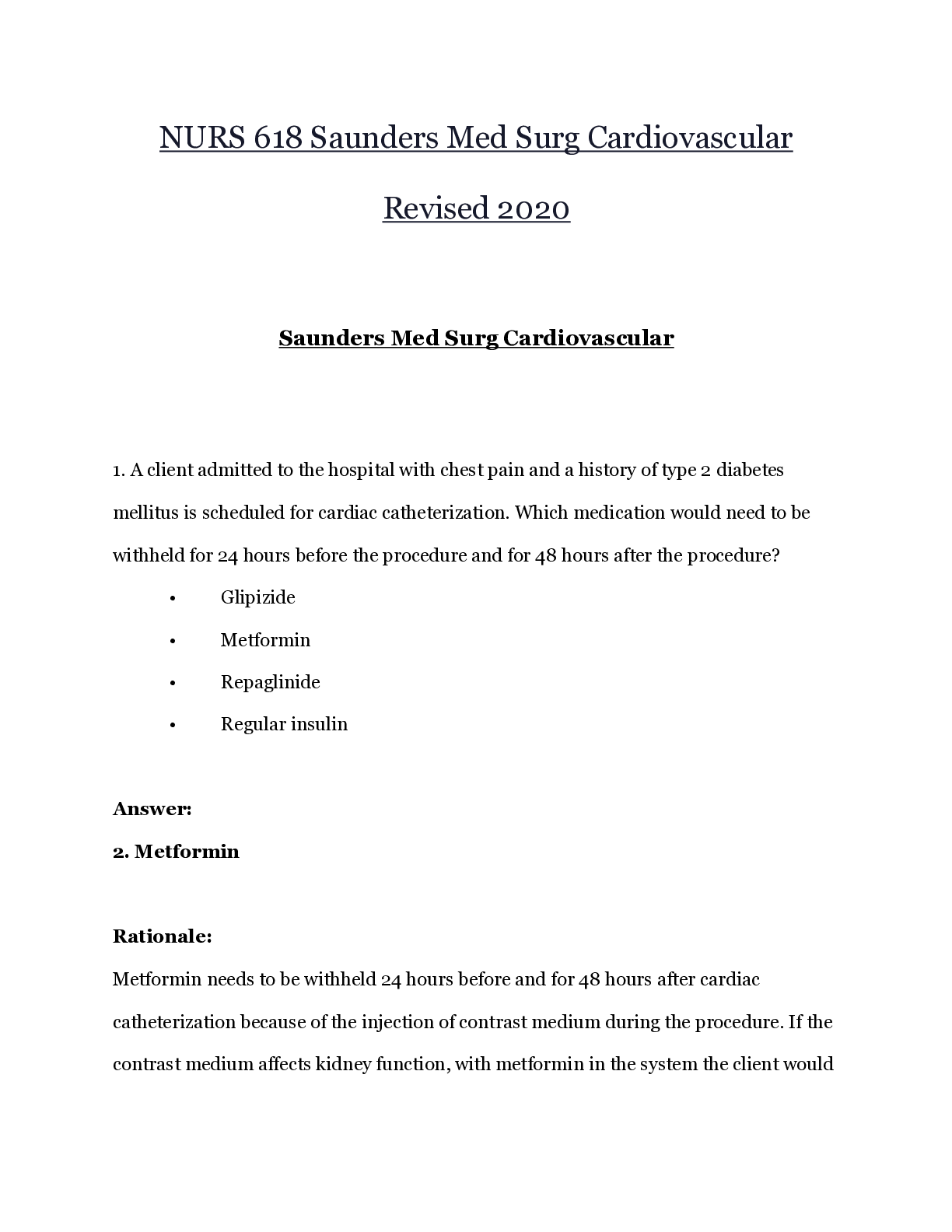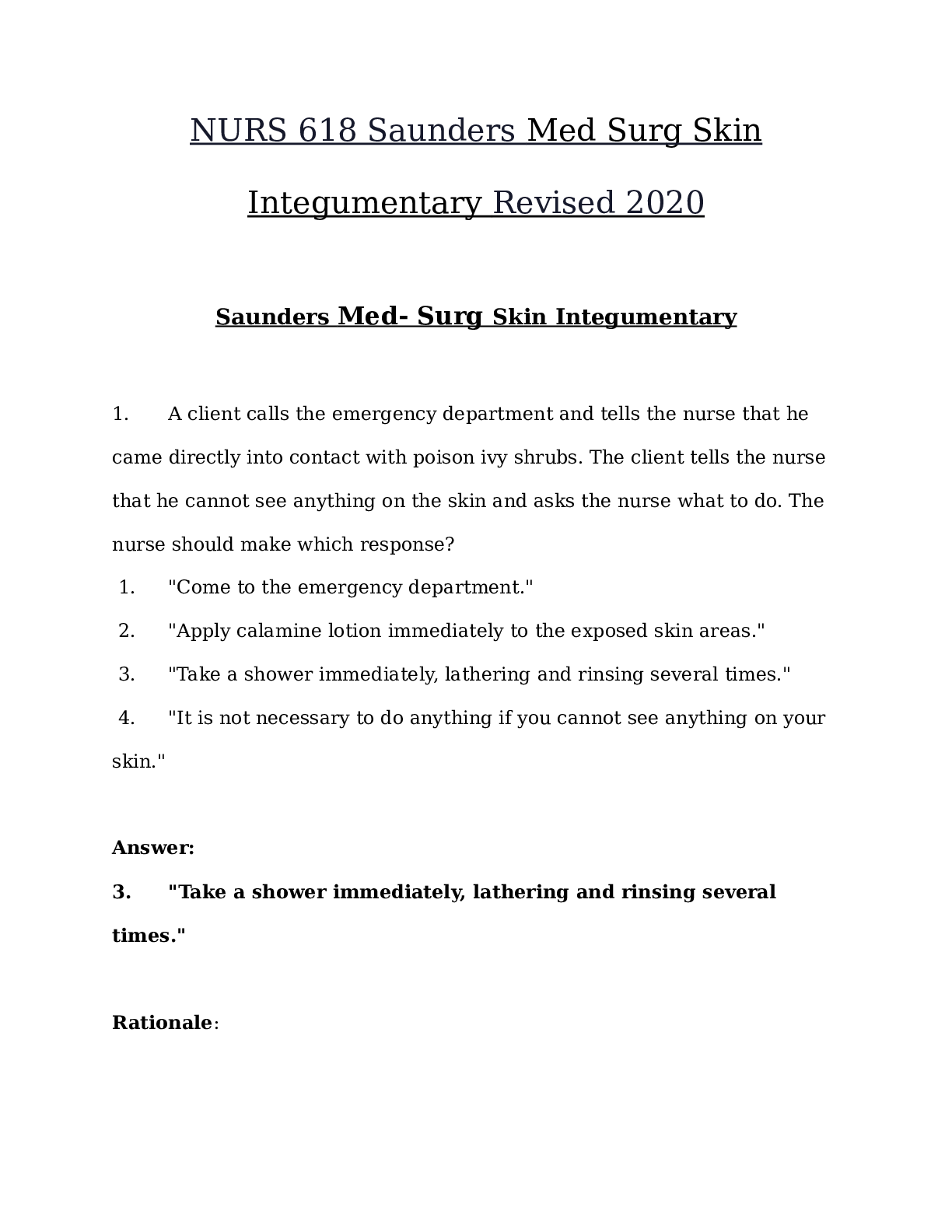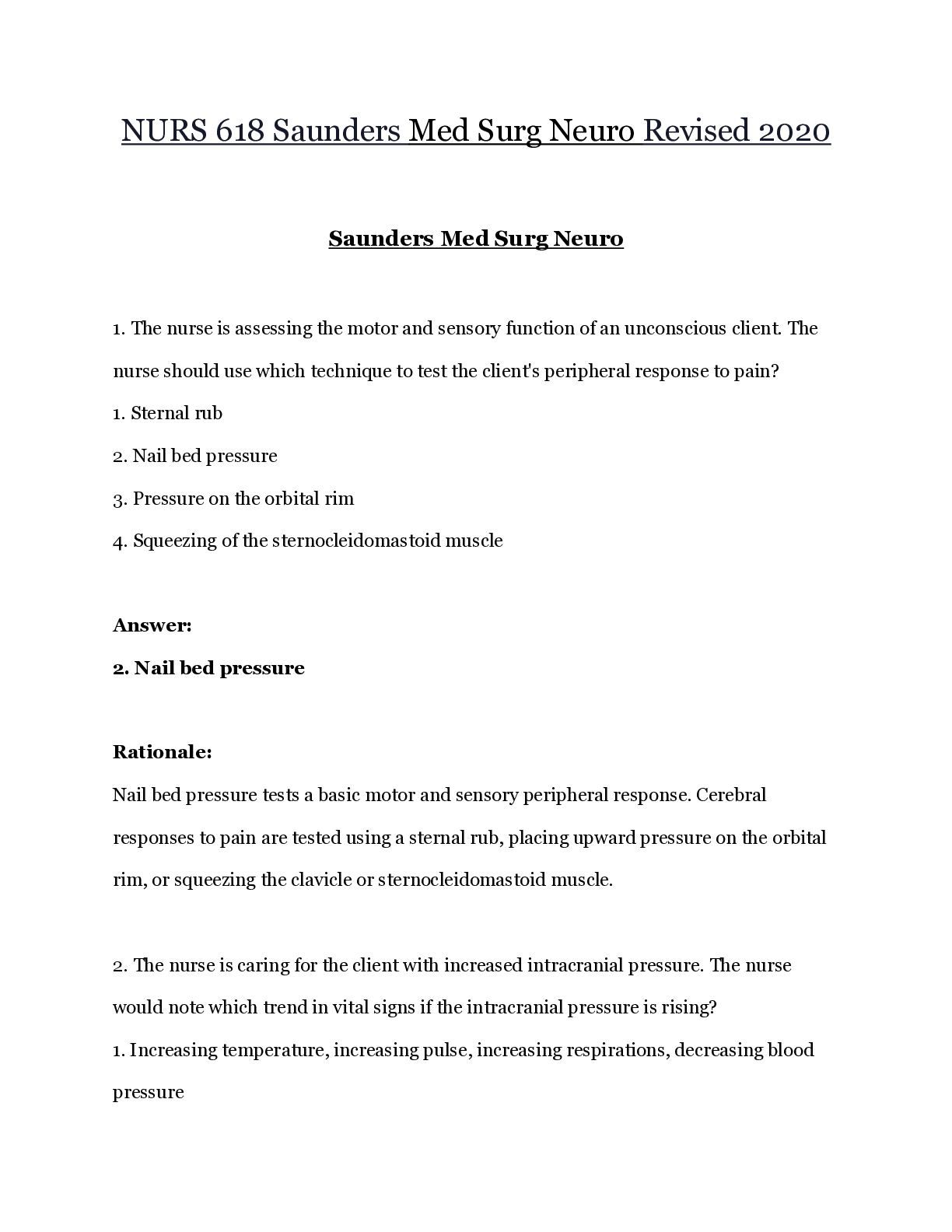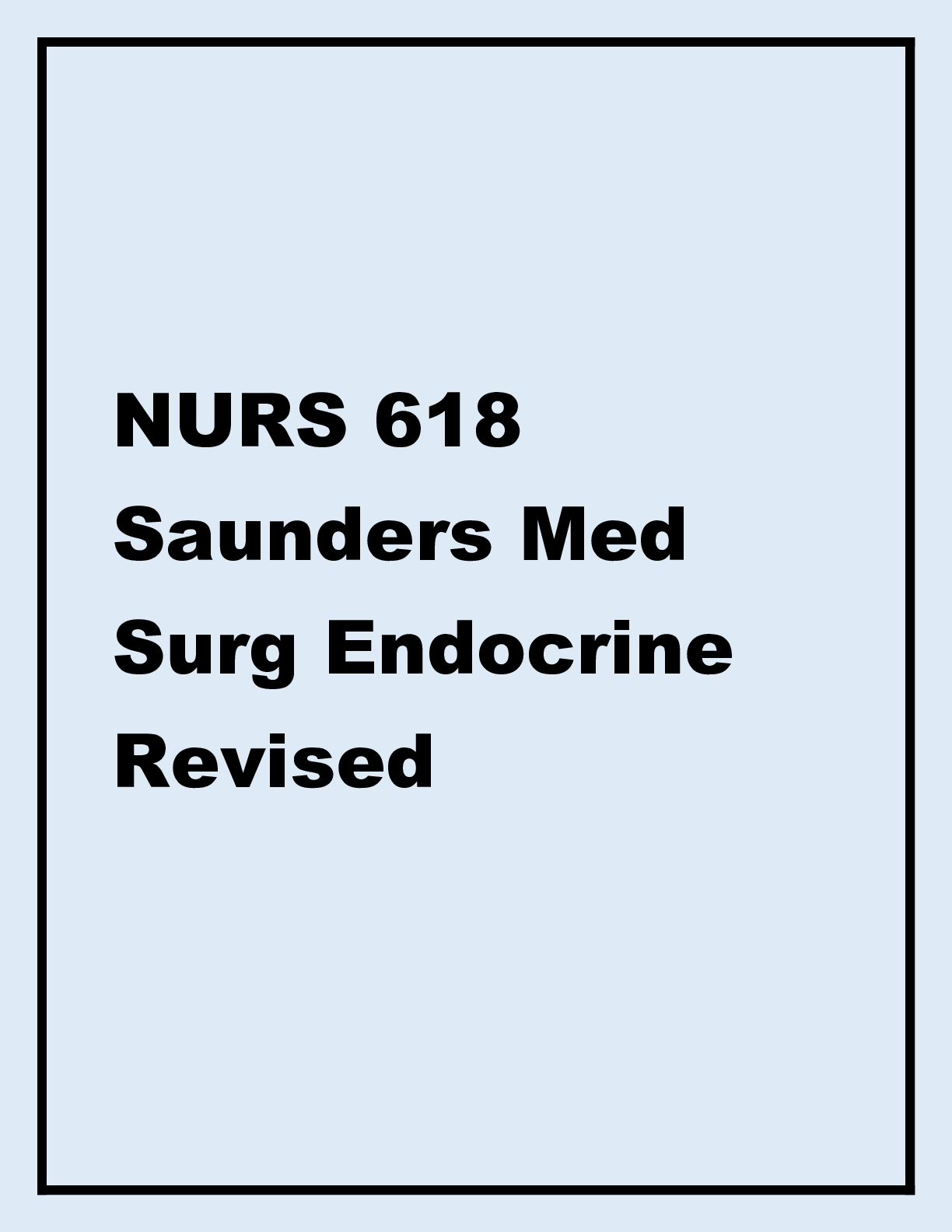*NURSING > MED-SURG EXAM > NURS 618 Saunders Med Surg Skin Integumentary Revised 2020 | NURS618 Saunders Med Surg Skin Integume (All)
NURS 618 Saunders Med Surg Skin Integumentary Revised 2020 | NURS618 Saunders Med Surg Skin Integumentary
Document Content and Description Below
NURS 618 Saunders Med Surg Skin Integumentary Revised 2020 70+ pages of questions with answers Saunders Med- Surg Skin Integumentary 1. A client calls the emergency department and tells the nurse... that he came directly into contact with poison ivy shrubs. The client tells the nurse that he cannot see anything on the skin and asks the nurse what to do. The nurse should make which response? 1. "Come to the emergency department." 2. "Apply calamine lotion immediately to the exposed skin areas." 3. "Take a shower immediately, lathering and rinsing several times." 4. "It is not necessary to do anything if you cannot see anything on your skin." Answer: 3. "Take a shower immediately, lathering and rinsing several times." Rationale: When an individual comes in contact with a poison ivy plant, the sap from the plant forms an invisible film on the human skin. The client should be instructed to cleanse the area by showering immediately and to lather the skin several times and rinse each time in running water. Removing the poison ivy sap will decrease the likelihood of irritation. Calamine lotion may be one product recommended for use if dermatitis develops. The client does not need to be seen in the emergency department at this time. 2. A client is being admitted to the hospital for treatment of acute cellulitis of the lower left leg. During the admission assessment, the nurse expects to note which finding? 1. An inflammation of the epidermis only 2. A skin infection of the dermis and underlying hypodermis 3. An acute superficial infection of the dermis and lymphatics 4. An epidermal and lymphatic infection caused by Staphylococcus Answer: 2. A skin infection of the dermis and underlying hypodermis Rationale: Cellulitis is an infection of the dermis and underlying hypodermis that results in a deep red erythema without sharp borders and spreads widely throughout tissue spaces. The skin is erythematous, edematous, tender, and sometimes nodular. Erysipelas is an acute, superficial, rapidly spreading inflammation of the dermis and lymphatics. The infection is not superficial and extends deeper than the epidermis. 3. The clinic nurse assesses the skin of a client with psoriasis after the client has used a new topical treatment for 2 months. The nurse identifies which characteristics as improvement in the manifestations of psoriasis? Select all that apply. 1. Presence of striae 2. Palpable radial pulses 3. Absence of any ecchymosis on the extremities 4. Thinner and decrease in number of reddish papules 5. Scarce amount of silvery-white scaly patches on the arms Answers: 4. Thinner and decrease in number of reddish papules 5. Scarce amount of silvery-white scaly patches on the arms Rationale: Psoriasis skin lesions include thick reddened papules or plaques covered by silvery-white patches. A decrease in the severity of these skin lesions is noted as an improvement. The presence of striae (stretch marks), palpable pulses, or lack of ecchymosis is not related to psoriasis. 4. The clinic nurse notes that the health care provider has documented a diagnosis of herpes zoster (shingles) in the client's chart. Based on an understanding of the cause of this disorder, the nurse determines that this definitive diagnosis was made by which diagnostic test? 1. Positive patch test 2. Positive culture results 3. Abnormal biopsy results 4. Wood's light examination indicative of infection Answer: 2. Positive culture results Rationale: With the classic presentation of herpes zoster, the clinical examination is diagnostic. However, a viral culture of the lesion provides the definitive diagnosis. Herpes zoster (shingles) is caused by a reactivation of the varicella-zoster virus, the virus that causes chickenpox. A patch test is a skin test that involves the administration of an allergen to the surface of the skin to identify specific allergies. A biopsy would provide a cytological examination of tissue. In a Wood's light examination, the skin is viewed under ultraviolet light to identify superficial infections of the skin. 5. A client returns to the clinic for follow-up treatment following a skin biopsy of a suspicious lesion performed 1 week ago. The biopsy report indicates that the lesion is a melanoma. The nurse understands that melanoma has which characteristics? Select all that apply. 1. Lesion is painful to touch. 2. Lesion is highly metastatic. 3. Lesion is a nevus that has changes in color. 4. Skin under the lesion is reddened and warm to touch. 5. Lesion occurs in body area exposed to outdoor sunlight. Answers: 2. Lesion is highly metastatic. 3. Lesion is a nevus that has changes in color. Rationale: Melanomas are pigmented malignant lesions originating in the melanin-producing cells of the epidermis. Melanomas cause changes in a nevus (mole), including color and borders. This skin cancer is highly metastatic, and a person's survival depends on early diagnosis and treatment. Melanomas are not painful or accompanied by sign of inflammation. Although sun exposure increases the risk of melanoma, lesions are most commonly found on the upper back and legs and on the soles and palms of persons with dark skin. 7. A client arriving at the emergency department has experienced frostbite to the right hand. Which finding would the nurse note on assessment of the client's hand? 1. A pink, edematous hand 2. Fiery red skin with edema in the nail beds 3. Black fingertips surrounded by an erythematous rash 4. A white color to the skin, which is insensitive to touch Answer: 4. A white color to the skin, which is insensitive to touch Rationale: Assessment findings in frostbite include a white or blue color; the skin will be hard, cold, and insensitive to touch. As thawing occurs, flushing of the skin, the development of blisters or blebs, or tissue edema appears. Options 1, 2, and 3 are incorrect. - - - - - - - - - - - - - - - - 99. Ultraviolet (UV) light therapy is prescribed as a component of the treatment plan for a client with psoriasis, and the nurse provides instructions to the client regarding the treatment. Which statement by the client indicates a need for further instruction? 1. "Treatments are limited to 2 or 3 times a week." 2. "The UV light treatments are given on consecutive days." 3. "Eye goggles need to be worn to prevent exposure to UV light." 4. "Just the area requiring treatment should be exposed to the UV light." Answer: 2. "The UV light treatments are given on consecutive days." Rationale: UV light treatments are limited to 2 or 3 times a week and are not given on consecutive days. Safety precautions are required during UV light therapy. It is best to expose only those areas requiring treatment to the UV light. Protective wraparound goggles prevent exposure of the eyes to UV light. The face should be shielded with a loosely applied pillowcase if it is unaffected. Direct contact with the lightbulbs of the treatment unit should be avoided to prevent burning of the skin. 100. The nurse prepares to care for a client with acute cellulitis of the lower leg. The nurse anticipates that which interventions will be prescribed for the client? Select all that apply. 1. Antibiotic therapy 2. Cold compresses to the affected area 3. Warm compresses to the affected area 4. Intermittent heat lamp treatments 4 times daily 5. Alternating hot and cold compresses continuously Answers: 1. Antibiotic therapy 3. Warm compresses to the affected area Rationale: Cellulitis is a skin infection into deeper dermal and subcutaneous tissues that results in a deep red erythema without sharp borders and spreads widely throughout tissue spaces. Warm compresses may be used to decrease the discomfort, erythema, and edema. After tissue and blood cultures are obtained, antibiotics will be initiated. The nurse should provide supportive care as prescribed to manage symptoms such as fatigue, fever, chills, headache, and myalgia. Heat lamps can cause more disruption to already inflamed tissue. Cold compresses and alternating cold and hot compresses are not the best measures. 101. Which individuals are most likely to be at risk for development of psoriasis? Select all that apply. 1. A 32-year-old African American 2. A woman experiencing menopause 3. A client with a family history of the disorder 4. An individual who has experienced a significant amount of emotional distress 5. A female client with a thin body frame who adheres to a regular exercise program Answers: 2. A woman experiencing menopause 3. A client with a family history of the disorder 4. An individual who has experienced a significant amount of emotional distress Rationale: Psoriasis is a chronic, noninfectious skin inflammation involving keratin synthesis that results in psoriatic patches. Various forms exist, with psoriasis vulgaris being the most common type. Possible causes of the disorder include stress, trauma, infection, hormonal changes, obesity, an autoimmune reaction, and climate changes; a genetic predisposition may also be a cause. The disorder also may be exacerbated by the use of certain medications. Psoriasis occurs equally among women and men, although the incidence is lower in darker-skinned races and ethnic groups. 102. A 60-kg client has sustained third-degree burns over 40% of the body. Using the Parkland (Baxter) formula, the minimum fluid requirements are which during the first 24 hours after the burn? 1. 1200 mL of 5% dextrose in water solution 2. 2400 mL of 0.45% normal saline solution 3. 4800 mL of 0.9% normal saline solution 4. 9600 mL of lactated Ringer's solution Answer: 4. 9600 mL of lactated Ringer's solution Rationale: The Parkland (Baxter) formula is 4 mL of lactated Ringer's solution × kg body weight × percent burn. The calculation is performed as follows: 4 mL × 60 kg × 40 = 9600 mL. 103. The nurse is evaluating fluid resuscitation attempts in the burn client. Which finding indicates adequate fluid resuscitation? 1. Disorientation to time only 2. Heart rate of 95 beats/minute 3. +1 palpable peripheral pulses 4. Urine output of 30 mL over the past 2 hours Answer: 2. Heart rate of 95 beats/minute Rationale: When fluid resuscitation is adequate, the heart rate should be less than 120 beats/minute, as indicated in option 2. In addition, adequacy of fluid volume resuscitation can be evaluated by determining if urine output is at least 30 mL/hour, peripheral pulses are +2 or better, and the client is oriented to client, place, and time. 104. The nurse is assessing a dark-skinned client for the presence of petechiae. Which body area is the best for the nurse to check in this client? 1. Sclera 2. Oral mucosa 3. Soles of the foot 4. Palms of the hand Answer: 2. Oral mucosa Rationale: In a dark-skinned client, petechiae are best observed in the conjunctivae and oral mucosa and in areas of lighter melanization such as the abdomen and buttocks. Jaundice would best be noted in the sclera of the eye. Cyanosis is best noted on the palms of the hands and soles of the feet. 106. The nurse is performing assessment of the client who is admitted with left leg cellulitis. What does the nurse anticipate finding on the assessment of the left lower extremity? 1. Pallor 2. Cyanosis 3. Erythema 4. Jaundice Answer: 3. Erythema Rationale: Cellulitis presents with erythema (redness), which is localized inflammation. Options 1, 2, and 4 are not signs or symptoms of cellulitis. 107. A client complains of chronic pruritus. Which diagnosis should the nurse expect to note documented in the client's medical record that would support this client's complaint? 1. Anemia 2. Hypothyroidism 3. Diabetes mellitus 4. Chronic kidney disease Answer: 4. Chronic kidney disease Rationale: Clients with chronic kidney disease often have pruritus, or itchy skin. This is because of impaired clearance of waste products by the kidneys. The client who is markedly anemic is likely to have pale skin. Hypothyroidism may lead to complaints of dry skin. Clients with diabetes mellitus are at risk for skin infections and skin breakdown. 108. A client being seen in an ambulatory clinic for an unrelated complaint has a butterfly rash noted across the nose. The nurse interprets that this finding is consistent with early manifestations of which disorder? 1. Hyperthyroidism 2. Pernicious anemia 3. Cardiopulmonary disorders 4. Systemic lupus erythematosus (SLE) Answer: 4. Systemic lupus erythematosus (SLE) Rationale: An early sign of SLE is the appearance of a butterfly rash across the nose. Hyperthyroidism often leads to moist skin and increased perspiration. Pernicious anemia is exhibited by pale skin. Severe cardiopulmonary disorders may lead to clubbing of the fingers. 110. The nurse is teaching a client about changes in body image related to chronic obstructive pulmonary disease (COPD). Which statement by the client would indicate that teaching was successful? 1. "My nails may become clubbed." 2. "My nails may have multiple small pits." 3. "I may develop flattening of the nail plate." 4. "I may develop horizontal depressions on my nails." Answer: 1. "My nails may become clubbed." Rationale: A client with COPD will have clubbing of the nails, described as an angle between the nail plate and the proximal nail fold exceeding 180 degrees. Psoriasis is represented by multiple small pits in the nail bed. Flattening of the nail plate is caused by several conditions, such as iron deficiency anemia and poorly controlled diabetes for greater than 15 years. Horizontal depression across the nail beds is caused by medical problems, such as acute, severe illness and isolated periods of severe malnutrition. 111. The nurse is teaching a client who is preparing for discharge from the hospital after having a stroke about prevention of pressure ulcers while the client has limited mobility. Which statement by the client indicates the need for further teaching? 1. "I will inspect my skin daily." 2. "I can sit in my favorite chair all day." 3. "I need to drink at least 2 liters of fluid daily." 4. "I will make sure that my skin is clean and well moisturized." Answer: 2. "I can sit in my favorite chair all day." Rationale: Sitting in one position all day can be a risk factor for pressure ulcer development. Options 1, 3, and 4 are preventative measures for pressure ulcer development. 112. The nurse is caring for a client with a diabetic ulcer. What discharge instructions should the nurse provide to the client? Select all that apply. 1. Wash feet with hot water daily. 2. Use a mild soap when washing the feet. 3. Use lanolin on the feet to prevent dryness. 4. Wear open-toed shoes to allow air flow to the feet. 5. Exercise the feet daily by walking and flexing at the ankle. Answers: 2. Use a mild soap when washing the feet. 3. Use lanolin on the feet to prevent dryness. 5. Exercise the feet daily by walking and flexing at the ankle. Rationale: The client with a diabetic ulcer needs to take strict precautions and implement very specific measures to allow for wound healing. Interventions include washing the feet with warm (not hot) water daily with a mild soap, using lanolin to prevent drying and cracking, wearing closed-toed shoes that are well fitting and avoiding high-heel and open-toed shoes, and exercising the feet daily by walking and flexing at the ankle to promote circulation. 113. An older client has been lying in a supine position for the past 3 hours. The nurse who is repositioning this client would be most concerned with examining which bony prominences of the client? Select all that apply. 1. Heels 2. Ankles 3. Elbows 4. Sacrum 5. Back of the head 6. Greater trochanter Answers: 1. Heels 3. Elbows 4. Sacrum 5. Back of the head Rationale: When the client is lying supine, the heels, sacrum, and back of the head are all at risk, as are the elbows and scapulae. The greater trochanter and ankles are at greater risk of skin breakdown from excessive pressure when the client is in the side-lying position. 114. An adult client trapped in a burning house has suffered burns to the back of the head, the upper half of the posterior trunk, and the back of both arms. Using the rule of nines, what percentage does the nurse determine the extent of the burn injury to be? Fill in the blank. Answer: 22.5% Rationale: According to the rule of nines, the posterior side of the head equals 4.5%, the back of both arms equals 9%, and the upper half of the posterior trunk equals 9%, totaling 22.5%. 115. The nurse is planning care for a client returning from the operating room after having an autograft applied to the right lower extremity. Which nursing intervention is focused on promoting graft "take"? 1. Monitor temperature every 4 hours. 2. Leave the dressing intact for 3 to 5 days. 3. Maintain the right lower extremity in a dependent position. 4. Apply an ice pack to the site to decrease edema formation. Answer: 2. Leave the dressing intact for 3 to 5 days. Rationale: After surgery, graft sites are immobilized with bulky cotton pressure dressing for 3 to 5 days to allow vascularization, or "take," of the newly grafted skin. Dressings should not be disturbed. Elevation and complete rest of the grafted area is required to allow blood vessels to connect the graft with the wound bed. Any activity that might cause movement of the dressing against the body and separation of the graft from the wound is prohibited, such as application of an ice pack. Additionally, cold promotes vasoconstriction. [Show More]
Last updated: 1 year ago
Preview 1 out of 41 pages

Reviews( 0 )
Document information
Connected school, study & course
About the document
Uploaded On
Nov 07, 2020
Number of pages
41
Written in
Additional information
This document has been written for:
Uploaded
Nov 07, 2020
Downloads
1
Views
78
